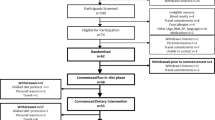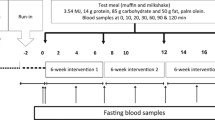Abstract
More than 40 years ago, saturated FA with 12, 14, and 16 carbon atoms (lauric acid, myristic acid, and palmitic acid) were demonstrated to be “hypercholesterolemic saturated FA.” It was further concluded that the serum total cholesterol level would hardly be changed by isocaloric replacement of stearic acid (18∶0) by oleic acid (cis-18∶1n−9) or carbohydrates. These earlier studies did not address the effects of the various FA on the serum lipoprotein profile. Later studies found that the hypercholesterolemic saturated FA increase serum total cholesterol levels by raising concentrations of both the atherogenic LDL and the antiatherogenic HDL. Consequently, the ratio of total to HDL cholesterol will hardly change when carbohydrates replace these saturated FA. Compared with other saturated FA, stearic acid lowers LDL cholesterol. Studies on the effects on HDL cholesterol are less conclusive. In some, the effects on HDL cholesterol were comparable to those of palmitic acid, oleic acid, and linoleic acid, whereas in others a decrease was observed. This may suggest that in this respect the source of stearic acid is of importance, which needs however further study. From all these studies, however, it can be concluded that stearic acid may decrease the ratio of total to HDL cholesterol slightly when compared with palmitic or myristic acid. Without doubt, the effects of stearic acid are more favorable than those of trans monounsaturated FA.
Similar content being viewed by others
References
Keys, A., Anderson, J.T., and Grande, F. (1965) Serum Cholesterol Response to Changes in the Diet. IV. Particular Saturated Fatty Acids in the Diet, Metabolism 14, 776–786.
Hegsted, D.M., McGandy, R.B., Myers, M.L., and Stare, F.J. (1965) Quantitative Effects of Dietary Fat on Serum Cholesterol in Man, Am. J. Clin. Nutr. 17, 281–295.
Grande, F., Anderson, J.T., and Keys, A. (1970) Comparison of Effects of Palmitic and Stearic Acids in the Diet on Serum Cholesterol in Man, Am. J. Clin. Nutr. 23, 1184–1193.
Bonanome, A., and Grundy, S.M. (1988) Effect of Dietary Stearic Acid on Plasma Cholesterol and Lipoprotein Levels, N. Engl. J. Med. 318, 1244–1248.
Denke, M.A., and Grundy, S.M. (1991) Effects of Fats High in Stearic Acid on Lipid and Lipoprotein Concentrations in Men, Am. J. Clin. Nutr. 54, 1036–1040.
Zock, P.L., and Katan, M.B. (1992) Hydrogenation Alternatives: Effects of trans Fatty Acids and Stearic Acid Versus Linoleic Acid on Serum Lipids and Lipoproteins in Humans, J. Lipid Res. 33, 399–410.
Kris-Etherton, P.M., Derr, J., Mitchell, D.C., Mustad, V.A., Russell, M.E., McDonnel, E., Salabsky, D., and Pearson, T.A. (1993) The Role of Fatty Acid Saturation on Plasma Lipids, Lipoproteins, and Apoproteins: I. Effects of Whole Food Diets High in Cocoa Butter, Olive Oil, Soybean Oil, Dairy Butter, and Milk Chocolate on the Plasma Lipids of Young Men, Metabolism 42, 121–129.
Tholstrup, T., Marckmann, P., Jespersen, J., and Sandström, B. (1994) Fat High in Stearic Acid Favorably Affects Blood Lipids and Factor VII Coagulant Activity in Comparison with Fats High in Palmitic Acid or High in Myristic Acid, Am. J. Clin. Nutr. 59, 371–377.
Dougherty, R.M., Allman, M.A., and Iacono, J.M. (1995) Effects of Diets Containing High or Low Amounts of Stearic Acid on Plasma Lipoprotein Fractions and Fecal Fatty Acid Excretion of Men, Am. J. Clin. Nutr. 61, 1120–1128.
Aro, A., Jauhiainen, M., Partanen, R., Salminen, I., and Mutanen, M. (1997) Stearic Acid, trans Fatty Acids, and Dairy Fat: Effects on Serum and Lipoprotein Lipids, Apolipoproteins, Lipoprotein(a), and Lipid Transfer Proteins of Healthy Subjects, Am. J. Clin. Nutr. 65, 1419–1426.
Hunter, K.A., Crosbie, L.C., Weir, A., Miller, G.J., and Dutta-Roy, A.K. (2000) A Residential Study Comparing the Effects of Diets Rich in Stearic Acid, Oleic Acid, and Linoleic Acid on Fasting Blood Lipids. Hemostatic Variables and Platelets in Young Healthy Men, J. Nutr. Biochem. 11, 408–416.
Judd, J.T., Baer, D.J., Clevidence, B.A., Kris-Etherton, P., Muesing, R.A., and Iwane, M. (2002) Dietary cis and trans Monounsaturated and Saturated FA and Plasma Lipids and Lipoproteins in Men, Lipids 37, 123–131.
Zock, P.L., de Vries, J.H., de Fouw, N.J., and Katan, M.B. (1995) Positional Distribution of Fatty Acids in Dietary Triglycerides: Effects on Fasting Blood Lipoprotein Concentrations in Humans, Am. J. Clin. Nutr. 61, 48–55.
Mensink, R.P., Zock, P.L., Kester, A.D.M., And Katan, M.B. (2003) Effects of Dietary Fatty Acids and Carbohydrates on the Ratio of Serum Total to HDL Cholesterol and on Serum Lipids and Apolipoproteins: A Meta-analysis of 60 Controlled Trials, Am. J. Clin. Nutr. 77, 1146–1155.
Author information
Authors and Affiliations
Corresponding author
About this article
Cite this article
Mensink, R.P. Effects of stearic acid on plasma lipid and lipoproteins in humans. Lipids 40, 1201–1205 (2005). https://doi.org/10.1007/s11745-005-1486-x
Received:
Accepted:
Issue Date:
DOI: https://doi.org/10.1007/s11745-005-1486-x




